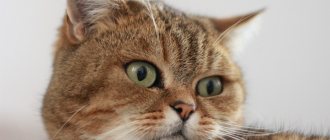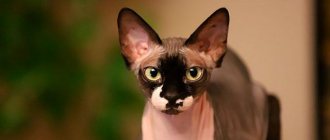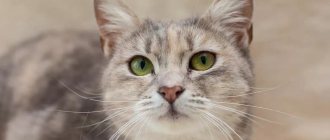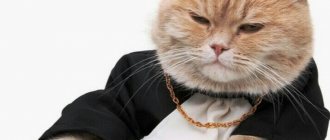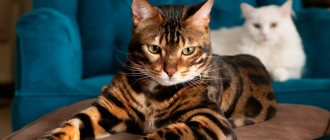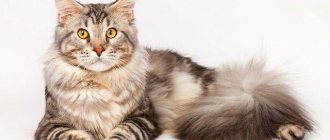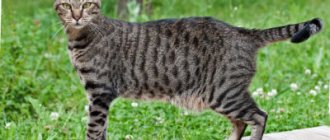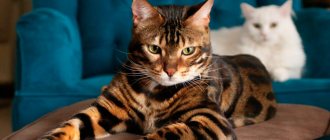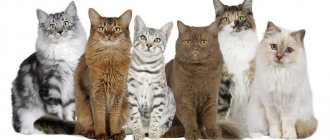Elves are unusual hairless cats with graceful movements and ears turned outward. Their exotic appearance evokes associations with the heroes of ancient fairy tales and makes you admire these cute creatures. And if you decide to get such a pet, it would be a good idea to find out how to choose the right kitten, what the standards are for this breed and the basic rules for caring for hairless animals.
Brief history of the breed
The elves were bred in the USA thanks to the dedicated work of American breeder Kristen Lead. After the death of her Sphynx pet, the woman decided to try to get similar cats that would not have a predisposition to serious hereditary pathologies.
To develop a new breed, Lead and her friend Karen Nelson decided to use Canadian Sphynxes and American Curls. The first few attempts were unsuccessful. But Lid did not lose hope and as a result received cats that resembled fairy-tale characters.
In 2006, elves were evaluated at TICA shows, and in 2007 they were given the status of an experimental breed.
Origin story - how a bald elf turned out from a sphinx cat
Elves are one of the experimental breeds.
They differ on several points at once - a completely naked body, voluminous ears with curved tips and a peaceful disposition. The breed is still experimental and not recognized by phenological associations. Obtained by mating American Curls and Sphynxes.
Elven ears
American Curls were chosen as a partner for the Sphinx. It was planned to adopt from the former the absence of hair on the skin, from the latter - strong immunity and not a tendency to genetic diseases. The experiments continued for 16 years and ended in 2006, when they achieved the result - hairless kittens that looked like aliens. Looking at the photo, you can see the similarity of cats of this breed with fairy-tale elves. That's why they called it that.
Elf breed folds
They received official status in 2007, assigned by the TICA association. But for now it is considered experimental and continues to be studied.
Meows
Baby
At home
Family
tonsil eyes
White color
Mother cat
In the nursery
On the holiday
Two colors
Interesting Facts
In the short time the breed has existed, many interesting things have been associated with it:
- Elves are very rare and expensive cats. Since nurseries specializing in breeding the breed are concentrated in the United States, the average price of such a kitten is $1,500-2,000.
- These cats received the name “elf” due to their unusual appearance and bizarrely curved ears. And because of their resemblance to hairless Canadians, they are often called elven sphinxes.
- Due to the difficulties associated with finding a partner for mating, in some countries it is not prohibited to crossbreed Canadian Sphynxes and elves. True, kittens born from such a mating will be considered mestizos and some of them will turn out to be straight-eared.
Disqualifying faults
In felinology, serious defects are those external features that are strikingly different from the standard accepted by the organization. If they are present, the individual is removed from the exhibition and can no longer take part in them. Disqualified cats are not allowed to be bred and are automatically transferred to the “pet” class.
Despite the fact that Elves are not registered in any association, breeders identify a number of negative traits that close the road to the show ring:
- improperly developed tail;
- asymmetrical ears;
- straight type;
- Ears that are too curled, with the tips touching the outside of the ears or the skull.
Disadvantages due to which an individual is penalized in the ring:
- overweight;
- rough or soft bone;
- flat ears, sharp break;
- any signs that differ from the standard ears - corrugated texture, excessively low or high set, sharp tip, tilting to the sides;
- square, small and compact body;
- too large or small size at the withers;
- deep nasal stop.
Breed description, standards, appearance
The Elven Sphynx is a hairless, slender cat with impressive coordination, long limbs, a graceful neck and curled ear tips.
In detail - “About breeds of cats with curled ears.”
Dimensions and weight
Elves are fairly large cats with pronounced sexual dimorphism. The weight of an adult male of this breed is 7-8 kg. The weight of an elven cat varies between 5-6 kg.
Anatomical characteristics
Ideally, an elf cat should meet the following description:
- The head is wedge-shaped, with prominent cheekbones, developed whisker pads and a flat forehead. The nose is straight, with a slight dent in the bridge of the nose. The eyebrows and whiskers are broken, and in some pets they are completely absent.
- The eyes are almond-shaped, large, slightly convex. The iris can be colored green, blue or yellow. According to the standard, heterochromia is allowed in elven sphinxes.
- Elves' ears are large, wide at the base, with curved, pointed tips. The tilt angle varies between 90-180 degrees. The stable cartilage should account for at least 1/3 of the length of the ear tissue.
- The body of an elf cat is lean, muscular, with a convex belly, which gives the elf a pear-shaped body. The neck is long, with a graceful curve. The chest is round and wide.
- The limbs are strong, slender with wide oval pads. The elf's hind legs are slightly shorter than his front ones. Because of this, it seems that the cat moves with a sneaking gait.
- The elf's tail is whip-like, long, wide at the base, with a pointed tip. At rest, strongly twisted.
Color and coat type
The body of the elven sphinx is covered with hot, thick, slightly grainy skin that feels like suede. There are pronounced folds near the shoulders, between the ears and around the muzzle. Short hairs may grow on the tail, paws, outside of the ears and the bridge of the nose, the length of which should not exceed 2 mm.
The color of the Elven Sphinx can be almost any color. The most common colors in the breed are beige, light gray, black and white. According to the standard, contrasting spots are allowed on the body of the Elven Sphinx.
Possible breed defects
Disadvantages in the presence of which the elf will not receive a high expert assessment:
- high-set ears, the angle of bend of which is more than 180 or less than 90 degrees;
- profusely pubescent body;
- rounded or grooved edge of the ears;
- the body is too massive or fragile;
- insufficient number of folds on the head;
- straight profile;
- narrowed head;
- twisted or deformed tail.
Options
The length at the withers for females and males is 30-40 cm. The maximum weight should not exceed 7 kg. Minimum values – 4-5 kg. If a cat weighs more than it should, it is considered to be obese and will be fined for this at the show.
Due to their accelerated metabolism, the normal temperature for Elves is 38-39 degrees. Hairless cats have to spend more energy warming up their bodies. Therefore, representatives of the entire Sphinx family need to eat more and stay in a warm room on a permanent basis.
Character and temperament
The elf cat is endowed with a sociable and good-natured disposition. She quickly gets used to people and tries in every possible way to demonstrate her affection. A cat of this breed loves to be the center of attention and does not tolerate loneliness well.
On a note. Elven Sphynxes are very theatrical and mannered cats, prone to demonstrative “playing for the audience.” They can be capricious and often try to attract attention to themselves.
The Elf cat loves children very much and gets along well with kids. He is very careful in his play and is patient with children's pranks.
The sociable and friendly disposition of the Elven Sphynx allows him to easily find a common language with different pets. A cat of this breed will not conflict with either its brothers or non-aggressive dogs.
How to choose the right kitten
Elven sphinxes are not very common outside the United States. In Russia there are only a few nurseries specializing in breeding this breed. Therefore, the search for a kitten may take a long time. To speed up the process and quickly become the owner of an exotic pet, it is better to contact foreign breeders.
Before making a final decision on purchasing an Elf cat, you need to make sure that he has documents confirming his breed and vaccinations. It also doesn’t hurt to look at the behavior of the kids and the conditions in which they are kept.
It is important that the kitten you like has a slender body covered with folded skin, a convex but not bloated belly and large ears with tips curved back.
On a note. The formation of the curve of the auricle in elven sphinxes is completed by 4-6 months. Kittens are born with straight ears, the tips of which begin to curl after a few days.
Kitten care
Weaning from the mother too early can negatively affect the character and health of little elves. Therefore, responsible breeders begin giving away kittens once they are 12 weeks old. By this age, elven sphinxes eat many foods without problems, know the litter box and know how to use a scratching post.
New owners will only have to show the pet where its toilet and bowls of water and food are located.
In order for the elf kitten to quickly get used to the changed conditions, he is given more attention and care. To avoid digestive problems due to a sudden change in diet, the hairless pet is initially fed what it ate from the breeder.
New products are introduced into the cat's menu gradually, and it should be monitored to see if they cause allergies. The elf's feeding schedule depends on the pet's age:
- 3-6 months – 4-5 times a day;
- 6-12 months – 3 times a day;
- from 12 months – 2 times a day.
On a note. Little elves are incredibly inquisitive and try to get into the most inaccessible corners of the apartment.
To protect them, wires, ornamental plants, household chemicals, and fragile and small items are kept away from kittens. And to prevent the Elven Sphinx from becoming a victim of its curiosity, you need to keep the doors of ovens, washing machines and dryers closed.
Knitting features
The first heat in cats occurs at about six months, but this is too early an age for pregnancy - the animal’s body continues to form, so the offspring may be born weak or even dead. In the future, the cat that gave birth early will suffer from chronic diseases.
The best time for the first mating is 12–18 months. The duration of pregnancy depends on the age and health of the female, the number of fetuses and a number of other factors. On average it lasts 62–68 days. A litter can have from 1 to 5 kittens. Crossing of elves with Canadian Sphynxes is allowed, but such offspring are valued less than purebred ones.
Parental instinct is well expressed in both male and female cats.
Kittens that do not have breeding value can be sold by breeders already castrated or sterilized. Sometimes the responsibility to sterilize the pet falls on the new owner, and this clause is included in the official contract.
Experts differ regarding the best time for castration. Most domestic veterinarians consider 9–12 months to be the optimal age. In Europe, earlier operations are also common.
Breeding elves
The breed is still very small, so the main difficulty awaiting the breeder is directly purchasing studs, as well as finding a partner for the animal, if there is only one. This may even require international travel.
Please note that kittens do not always inherit one of the main breed characteristics, that is, curled ears. The gene for curled ears (Cu) is dominant, while the gene for straight ears (cu) is recessive. The chances of getting the right kittens depend on the pedigree of the parents and are calculated as follows:
- When mating two elves of the second or third generation (CuCu), the probability of getting kittens with curled ears is 100%.
- If sires are born from a curl and a sphinx or an elf and a sphinx, a quarter of their offspring may be straight-eared, and in addition, the litter will include individuals with curled ears, while having a recessive gene (Cucu).
- When mating an elf with a recessive gene and a Canadian Sphynx, approximately half of the babies will have curved ears, and half will have straight ears.
- All offspring of a sphinx and an elf with dominant genes will have folded ears, but some kittens will also be carriers of a recessive gene.
At the same time, it is impossible to predict whether the bend will comply with the standards: show-class parents may give birth to kittens with the wrong degree of ear curvature and vice versa.
The shape of kittens' ears depends on the pedigree of the parents.
Please note that the offspring of an elf and a sphinx will be more susceptible to genetic diseases.
The normal frequency of births for a breeding cat is once a year, with good health and easy pregnancies - 3 times every 2 years, but no more. Before mating, you should carefully check all the animal’s documents, including a medical card and pedigree, preferably for at least 3–4 generations. Before mating, both cats and female cats must be vaccinated and treated for worms. The breeder's responsibilities include conducting a course of vaccinations, deworming the kittens and processing their documents.
Usually the search for a cat for mating is carried out through nurseries. Private advertisements should be treated with extreme caution and all documents should be carefully checked.
Care and maintenance
The body of elves is not protected by a fluffy fur coat. Therefore, the care and maintenance of these hairless cats is slightly different from the care of their ordinary counterparts. There should be no drafts in the rooms where elven sphinxes live. Also, the temperature there must be constantly maintained at 20-25 °C.
On a note. Elven sphinxes love warmth very much. To prevent hairless cats from getting burns, they need to be protected from direct sunlight.
The elf bed is set up in a quiet, cozy corner, away from heating appliances and electric fireplaces.
In order for a hairless cat to look neat, it is provided with proper hygienic care:
- Since representatives of the breed do not have eyelashes, their eyes are wiped daily with a cotton swab dipped in chamomile infusion or boiled water.
- The Elf cat's ears are regularly inspected for any unusual discharge. And the accumulated dirt is carefully removed with cotton pads moistened with a special lotion.
- The claws of the elven sphinx, as they grow, are extremely carefully shortened with a claw cutter so as not to injure living tissue.
- The cat's teeth are cleaned with a non-foaming toothpaste or a special brush 2 times a month.
- The skin of the elven sphinx is wiped daily with a piece of clean, soft, damp cloth. Particular attention is paid to folds in which keratinized particles and dust accumulate. Twice a month the cat is given bathing procedures. Bathe the elf in warm water using special shampoos for hairless breeds.
Health
Ocicat cat - description of the cat breed, red kitten
The creators of the breed made sure that elves did not suffer from any genetic diseases, so they do not have this predisposition. However, the lack of wool can cause a lot of trouble for breeders. During the cold season, cats run the risk of catching colds; in the warm season, on the contrary, there is a risk of overheating in the sun. Therefore, it is necessary to protect them from cooling and drafts and purchase special clothing.
Since the breed is hairless, there is a risk that they may scratch themselves. The resulting wounds may become inflamed. Therefore, it makes sense to purchase special silicone nail overlays. In addition, they may also have skin diseases: dermatitis, allergies, acne.
As can be seen from the description, the cat breed is relatively young, so there is no exact information about the life expectancy of elves yet, but, presumably, with proper care and feeding they can live 15-18 years.
Feeding the cat
Elven sphinxes are big eaters. Due to their accelerated metabolism, their diet should be enriched with calories, proteins, carbohydrates and fiber.
When feeding dry food, Elf cats are given high-quality premium or super-premium products, without any questionable additives. The following brands are best suited for representatives of the breed:
- Royal Canin;
- Acana;
- Monge;
- Gemon.
With natural feeding, the diet of the Elven Sphynx should consist of 70-80% lean fresh meat. Also, a cat of this breed is given:
- eggs;
- boiled vegetables;
- porridge with water;
- offal;
- lean sea fish;
- dairy products.
Elves are forbidden to give bones, fatty meat, sausage, smoked meats, pickles, sweets and baked goods. You also need to make sure that fresh milk and any leftovers from the owner’s table do not get into the cat’s bowl.
Catering
Natural products
Remember: feeding animals from your table is fraught with huge health problems in the future. Many things are simply destructive for cats! This applies to the following products:
- chocolate and all cocoa-containing products;
- grape;
- tomatoes;
- avocado;
- eggplant;
- bones;
- smoked meats;
- salty, spicy, sweet dishes;
- pickled products;
- alcohol and other human drinks;
- citrus;
- dog food.
You can give flour and baked goods, but just a little bit at a time.
Animals can be given water only with plain water: purified from harmful impurities and at a comfortable temperature. The liquid can be bought in a store, purified through a household (any) filter, or settled yourself.
Authorized products:
- Meat raw, boiled or stewed (raw retains more nutrients). These are chicken, veal, beef, turkey, rabbit, lamb, horse meat. Exotic varieties are also allowed: kangaroo meat, crocodile meat. The meat is cut into small pieces, frozen for 2-3 days, and doused with boiling water before serving. It is not recommended to grind it into mince: the animal, chewing pieces, trains its gums well.
- By-products: liver, kidneys, ventricles, chicken necks, cartilage. They are boiled or given raw.
- Fish without bones, fins and heads (salmon, trout, sea bass, saury, navaga, cod, flounder). It is better not to serve raw fish, but to first boil or stew it with vegetables. Since fish can provoke the development of urolithiasis, it should not be given more than once a week.
- Vegetable stew. Some cats like to chew raw ones, but there are few of them. Zucchini, carrots, pumpkin, broccoli, asparagus, spinach, green peas, herbs are allowed.
- Quail and chicken eggs. They are boiled and mixed with cereals. Of chicken, only the yolk is given.
- Porridge: millet, oatmeal, buckwheat, pearl barley, rice, semolina (it is fed to small kittens). The porridge is cooked in water without sugar, salt or seasonings, adding only half a teaspoon of vegetable oil.
Recommended food
Breeders strongly do not recommend feeding Dwelfs with industrial food. But if there are no other options, choose good quality food. No economy or premium feed! Holistic foods are ideal: Jaguar, Alleva Holistic, Grandorf.
| Holistic | Holistic | Super premium |
| Naturea | Wildcat | Organix |
Education and physical activity
The Elf cat breed is distinguished by high intelligence and cleanliness. These hairless pets easily learn the rules of behavior in the house and quickly get used to the tray and scratching post.
True, elven sphinxes are very vindictive and do not forgive insults. Therefore, it is necessary to raise a pet of this breed without rudeness or the use of physical force.
As children, Elf cats are very energetic and playful. And although the activity of pets decreases slightly with age, this does not mean that they will refuse to run after a ball or a laser pointer. Therefore, elven sphinxes should have several interactive toys and a corner with multi-level shelves.
Vaccinations and antiparasitic treatment
To protect the elf cat from viral and infectious diseases, it is vaccinated with a complex drug that stimulates the development of stable immunity:
- to calcivirus;
- rhinotracheitis;
- panleukopenia.
The first vaccination for an elf cat is given at the age of 7-8 weeks. After 4 weeks, the pet is vaccinated against the same diseases and against rabies. Subsequently, the elf is vaccinated on schedule once a year.
To prevent the cat from becoming infected with diseases carried by parasites, it is regularly treated for worms. The elf is given anthelmintic drugs 2 times a year with mandatory repetition after 10-14 days. The dose of the medicine is selected taking into account the weight of the pet.
Pros and cons of the breed
Elves, like cats of other breeds, have both advantages and disadvantages.
| pros | Minuses |
| Unusual appearance | High price |
| No shedding | Inability to tolerate low temperatures |
| High intelligence | Grudge |
Elves are affectionate and highly intelligent cats with an exotic appearance and good immunity. Thanks to their playful and good-natured disposition, representatives of the breed easily find a common language with all the inhabitants of the master’s apartment and are suitable for large families with small children.
Does elf cause allergies?
Many people are interested in whether elf cats are suitable for allergy sufferers, because they are hairless. In fact, most people are allergic not to fur, but to animal protein contained in their saliva and skin secretions. When a pet licks itself, it remains on the body. When dry, protein microparticles rise into the air and land on the mucous membranes, bronchi and lungs. An allergy sufferer almost immediately has a reaction - tearing, sore throat, coughing, sneezing. Conclusion - a cat's lack of hair does not mean that it is hypoallergenic.
